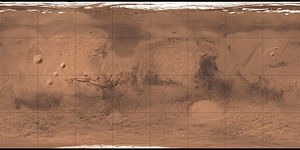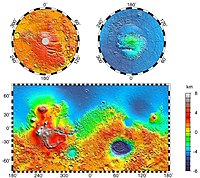Tharsis region
| Highlands on Mars | ||
|---|---|---|
| Tharsis region | ||

|
||
| The Tharsis region as a detail: 1. Olympus Mons , 2. Tharsis Tholus , 3. Ascraeus Mons , 4. Pavonis Mons , 5. Arsia Mons , 6. Valles Marineris | ||
|
|
||
| position | 0 ° 0 ′ N , 100 ° 0 ′ W | |
| surface | 4,000,000 km² | |
| history | ||
| Eponym | Tartessos | |
The Tharsis region is a very extensive area on the planet Mars with an area of approximately 4 million km². It was named after the ancient city and kingdom of Tartessos on the Iberian Peninsula, to which the biblical land of Tarsis may refer.
Its center lies west of the Valles Marineris rift system at the level of the Martian equator.
description
The Tharsis region rises like a bulge above the surface of Mars from which massive shield volcanoes protrude. The largest are Olympus Mons , Ascraeus Mons , Pavonis Mons and Arsia Mons , while the smaller ones are Biblis Patera in the west or Ulysses Patera in the center. To the west of the Tharsis Medusae Fossae region is to that of Yardangs embossed Eumenides dorsum .
Areology
Apparently the Tharsis region and the Valles Marineris formed together during the areological "Middle Ages" of Mars (the Hesperian period ), when the outer rock crust of the planet was bulged by internal forces. The region's volcanoes were active for very long periods of time and were extinct about 100 million years ago. During the active phase, huge masses of lava were released, forming extensive plains, such as Amazonis Planitia , west of Olympus Mons.
However, cooled lava flows have been detected on Olympus Mons, which are said to be around two million years old. This would be proof that the volcano erupted a short time ago geologically and may only be undergoing a dormant phase.
One assumption is that this volcanic activity was triggered by an impact event, the impact point of which was the Hellas Planitia basin on the opposite side of Mars.
More pictures
West side of Jovis Tholus , THEMIS image
Web links
- DLR: The Claritas Fossae area on the Tharsis plateau February 3, 2006
- DLR: Old and young impact craters in the Sirenum Fossae region , February 3, 2010
- DLR : Funnel chains on the Tharsis volcanic bulge Thursday, April 5, 2012
- DLR: Tectonic stress on Mars: the eyrie and ditch landscape of Ascuris Planum July 9, 2015
- DLR: Huge masses of water flowed through the Mangala and Minio valleys on Mars October 15, 2015
- DLR: Torn Martian crust in Sirenum Fossae , November 16, 2017
Individual evidence
- ^ Tharsis region in the Gazetteer of Planetary Nomenclature of the IAU (WGPSN) / USGS
- ↑ Mars volcanoes: Olympus Mons could still be active . In: Spiegel Online , November 24, 2004




